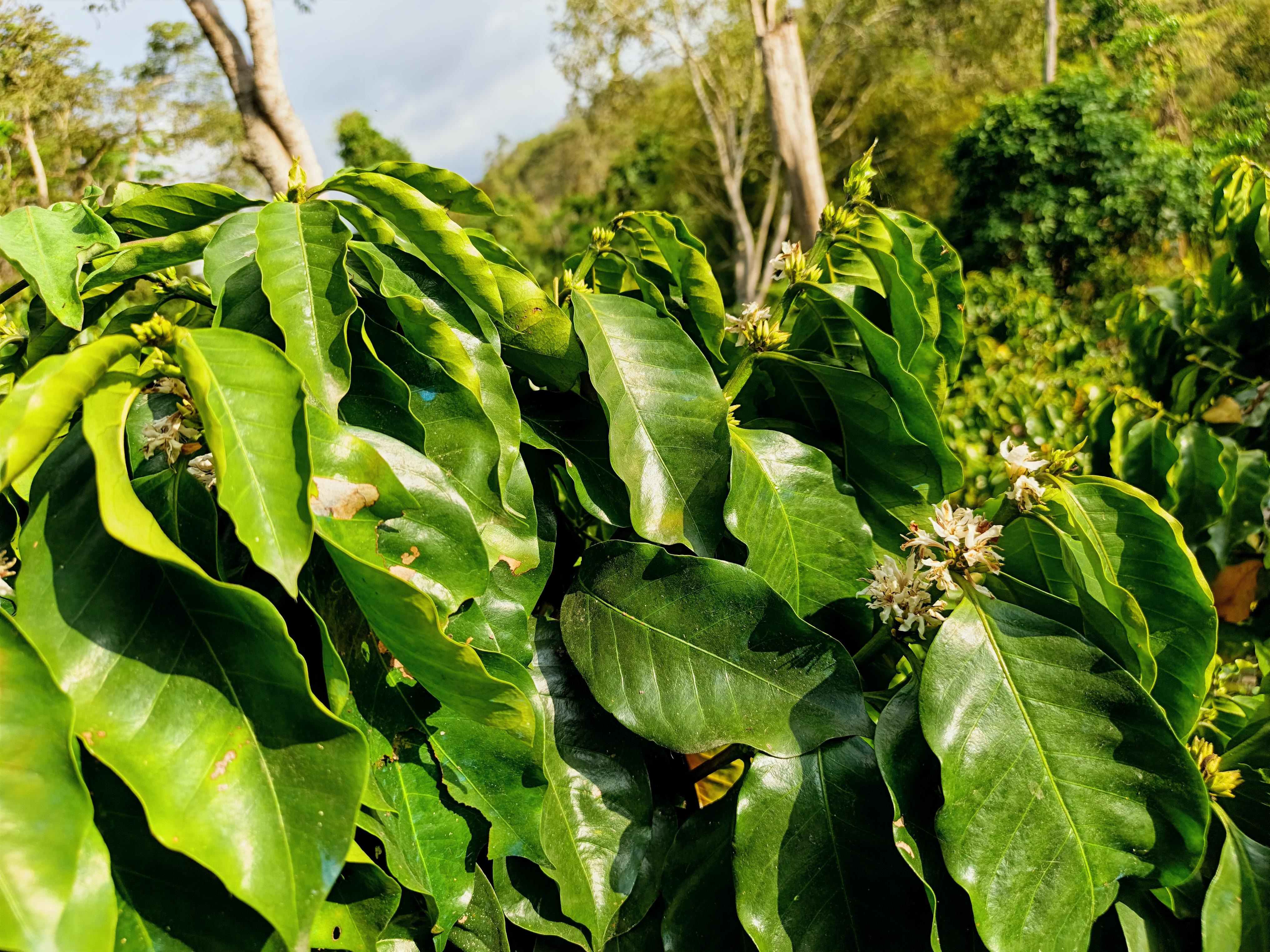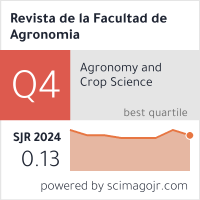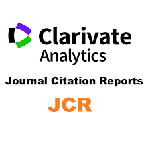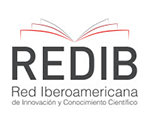Morphometric and phenotypic characteristics of eight genotypes of Coffea arabica L. during vegetative development
Abstract
Coffee production represents an important source of employment and economic dynamism for the south of the province of Manabí, so it is appropriate to identify the genotypes with the best morphological behaviour. The objective of the research was to evaluate the morphological and phenotypic variables of eight genotypes of Coffea arabica L. ("café arabica") in their third year of vegetative development, in order to identify the best morphological attributes for large-scale multiplication. A total of 348 plants of coffee genotypes Acawa, Catimor, Catucaí, Sarchimor, Bourbon yellow, Bourbon red, Manabi and Catuaí were evaluated. For the statistical analysis of the metric variables, a completely randomised design was used and linear regression, and for the analysis of the phenotypic variables, the chi-square statistical analysis was applied. The results showed highly significant differences (P<0.01) in all quantitative and qualitative variables. The genotype Acawa showed a better response for leaf length and branch length, Manabí 01 had greater petiole length and stem diameter; Catuaí showed greater number of branches, number of nodes and plant height, Bourbon yellow showed greater length between branches and greater internode length. As for the analysis of the qualitative variables, the colour of young leaves, the Bourbon revealed a reddish brown colour, the other genotypes are green; the leaf shape is oval, except for the Sarchimor that showed obovate leaves.
Downloads
References
Alemayehu, D. (2019). Estimation of Genetic Component and Heritability for Quantitative Traits in Amaro Coffee (Coffea Arabica L.) Landrace at Awada, Southern Ethiopia. International Journal of Research Studies in Science, Engineering and Technology, 6(11), 1–9. https://ijrsset.org/pdfs/v6-i11/1.pdf
Alvarado-Alvarado, G., & Ernesto Ochoa-Fonseca, H. (2006). Características fenotípicas de componentes de variedad castillo® en dos ambientes. 100 Cenicafé, 57(2), 100-121 https://www.cenicafe.org/es/publications/arc057%2802%29100-121.pdf
Álvarez H., Chele Campozano J., Ayon F., García C., & Valverde L. (2024). Efecto de dos alternativas de fertilización edáfica sobre el crecimiento de cuatro variedades de café arábigo. SPAMCIENCIA, 15, 1-8. https://doi.org/https://doi.org/10.51260/revista_espamciencia.v15iE.514
Bonomo, P., Damião Cruz, C., Marcelo Soriano Vlana, J., Alves Pereira, A., Rodrigues Ollvelra, V., & Crescêncio Souza Carneiro, P. (2004). Seleç ão antecipada de progênies de café descendentes de “híbrido de timor” x “catuaí amarelo” e “catuaí vermelho.” Acta Scientiarum. Agronomy, 26 (1), 91–96. https://www.alice.cnptia.embrapa.br/alice/bitstream/doc/779064/1/Selecaoantecipada...Bonomoetal2004.pdf
Castro, C. A., Indacochea, B., García, J., Gabriel, J., & González, M. (2024). Características morfológicas de 20 cultivares de café arábigo (Coffea arabica) en la finca Andil de la UNESUM. ESPAMCIENCIA, 15, 1–9. https://doi.org/https://doi.org/10.51260/revista_espamciencia.v15iE.540
Chen, Z. J. (2010). Molecular mechanisms of polyploidy and hybrid vigor. Trends in Plant Science, 15(2), 57–71. https://doi.org/10.1016/j.tplants.2009.12.003
Duicela G. L., Andrade, J., Farfán, D., & Velásquez S.. (2018). Calidad organoléptica, métodos de beneficio y cultivares de café robusta (Coffea canephora Pierre ex Froehner) en la amazonía del Ecuador. Revista Iberoamericana de Tecnología Postcosecha, 19(2), 1-8. https://www.redalyc.org/journal/813/81357541011/html/
Enríquez, J. P., Retes-Cálix, R. F., & Vásquez-Reyes, E. F. (2020). Importancia, genética y evolución del café en Honduras y el mundo. Innovare: Revista de Ciencia y Tecnología, 9(3), 149–155. https://doi.org/10.5377/innovare.v9i3.10649
Espinoza A., Váconez, G., Tapia, C., & Duicela G. (2021). Crecimiento, desarrollo y concentración de macronutrientes en genotipos de café (Coffea robusta P.) con diferentes dosis de abono orgánico. Ciencia Latina Revista Científica Multidisciplinar, 5(6), 11718–11734. https://doi.org/10.37811/cl_rcm.v5i6.1196
Ferwerda, F. P., & Der, B. (1969). Outlines of perennial crop breeding in the tropics by numerous authors edited by f. wit foundation for agricultural plant breeding wagenin gen. https://edepot.wur.nl/455436
François A., & Dussert, S.. (2016). Descriptores del café (Coffea spp. y Psilanthus spp.) (International Plant Genetic Resources Institute (IPGRI), Ed.). https://cgspace.cgiar.org/server/api/core/bitstreams/5b869086-7d8f-4fed-be0d-70101f2c2afe/content
Getachew, W., Sentayehu, A., & Taye, K. (2017). Genetic variability, heritability and genetic advance for quantitative traits in coffee (Coffea arabica L.) accessions in Ethiopia. African Journal of Agricultural Research, 12(21), 1824–1831. https://doi.org/10.5897/ajar2016.12059
Gordón-Mendoza, R., & Camargo-Buitargo, I. (2015). Selección de estadísticos para la estimación de la precisión experimental en ensayos de maíz. Agronomía Mesoamericana, 26(1), 55. https://doi.org/10.15517/am.v26i1.16920
Jiménez Buri, K. A., Quezada, J. M., & Vega Granda, A. del C. (2023). Análisis de las exportaciones del café en el Ecuador, periodo 2017-2021. Ciencia Latina Revista Científica Multidisciplinar, 7(1), 6166–6184. https://doi.org/10.37811/cl_rcm.v7i1.4909
Khemira, H., Mahdhi, M., Tounekti, T., Oteef, M. D. Y., Afzal, M., Alfaifi, Z., Sharma, M., Alsolami, W., & Shargi, D. (2024). Diversity among Coffea arabica populations in southwestern Saudi Arabia as revealed by their morphometric features. Notulae Botanicae Horti Agrobotanici Cluj-Napoca, 52(1), 1–22. https://doi.org/10.15835/nbha52113452
Milla Pino, M. E., Cruz, S. M. O., Espinoza, S. T. L., Silva, R. C., Torres, O. A. G., Gurbillón, M. Á. B., & Quintana, J. L. M. (2019). Agronomic behavior of three coffee varieties (Coffea arabica) under shade using longitudinal data. Acta Agronomica, 68(4), 271–277. https://doi.org/10.15446/acag.v68n4.70496
Mossie, G. A., Atinafu, G., & Mohammed, H. (2017). Agro-Morphological Characterization of Sidama Coffee (Coffea Arabica L.) Germplasm Accession under its Specialty Coffee Growing Area, Awada, Southern Ethiopia. International Journal of Research Studies in Science, Engineering and Technology, 4(12), 11–23. https://www.researchgate.net/publication/352509853
Olika K., Sentayehu A., Taye K., & Weyessa G. (2011). Variability of Quantitative Traits in Limmu Coffee (Coffea arabica L.) in Ethiopia. International Journal of Agricultural Research, 6, 482–493. https://doi.org/10.3923/ijar.2011.482.493
Orellana S. K. D., & Cañarte V. J. C. (2022). Bioestadística aplicada a investigaciones científicas en Salud (Mawil Publicaciones de Ecuador, Ed.; Primera). Mawil. https://doi.org/https://doi.org/10.26820/978-9942-602-23-7
Ortiz B., J., & Ortega, J. (2024). Obtención de genotipos mejorados de café (Coffea arabica L.) para la zona sur de Manabí, Ecuador. UNESUM - Ciencias. Revista Científica Multidisciplinaria, 8(2), 118–130. https://doi.org/10.47230/unesum-ciencias.v8.n2.2024.118-130
Plan de desarrollo y ordenamiento territorial del cantón Jipijapa 2019-2023. (2019). https://jipijapa.gob.ec/images/Planes/PDyOT%20GAD%20JIPIJAPA%202019-2023_signed.pdf
Ponce V., L., Orellana S., K., Acuña V., I., Alfonso A., J., & Fuentes F., T. (2018). Situación de la caficultura ecuatoriana: perspectivas. Revista Estudios Del Desarrollo Social: Cuba y América Latina, 15(1), 307–325. http://scielo.sld.cu/scielo.php?script=sci_arttext&pid=S2308-01322018000100015&lng=es&tlng=es.
Quiroga-Cardona, J. (2021). La resistencia incompleta del café a la roya: una revisión. Revista Cenicafé, 72(2), e72208. https://doi.org/10.38141/10778/72208
Valverde L., A., Leon T., M., Parrales V., J., Ayón V., F., Valverde L., W., & Gabriel-Ortega, J. (2025). Effects of organic fertilization on the morphometry and productivity of Sarchimor 4260 coffee in its second harvest. CENTROSUR, 1(25), 65–84. https://orcid.org/0009-0008-6958-2375
Valverde L, A., Vera V., R., Gutiérrez, S., M., Ayón V., N., Valverde L., W., & Chilán V., W. (2024). Evaluación morfológica de los híbridos de café arábiga Sarchimor 4260, Sarchimor 1669 y Manabí 01. ESPANCIENCIA, 15, 16–22. https://doi.org/https://doi.org/10.51260/revista_espamciencia.v15iE.515
Van der Vossen, H., Bertrand, B., & Charrier, A. (2015). Next generation variety development for sustainable production of arabica coffee (Coffea arabica L.): a review. Euphytica, 204(2), 243–256. https://doi.org/10.1007/s10681-015-1398-z
Venegas Sánchez, S., Orellana Bueno, D., & Pérez Jara, P. (2018). La realidad Ecuatoriana en la producción de café. RECIMUNDO, 2(2), 72–91. https://doi.org/10.26820/recimundo/2.(2).2018.72-91
Vera-Velásquez, F. B., Martin-Fernández, R. A., & Esquivel-García, R. (2024). Diagnóstico de la producción cafetalera en el cantón Jipijapa, provincia de Manabí, Ecuador. Revista Arbitrada Interdisciplinaria Koinonía, 9(17), 18–38. https://doi.org/10.35381/r.k.v8i17.3146
Villalta-Villalobos, J., & Gatica-Arias, A. (2019). A look back in time: Genetic improvement of coffee through the application of biotechnology. Agronomia Mesoamericana, 30(2), 577–599. https://doi.org/10.15517/am.v30i2.34173

Copyright (c) 2025 María José Galarza Pisco, Alfredo Valverde Lucio

This work is licensed under a Creative Commons Attribution-NonCommercial-ShareAlike 4.0 International License.


















